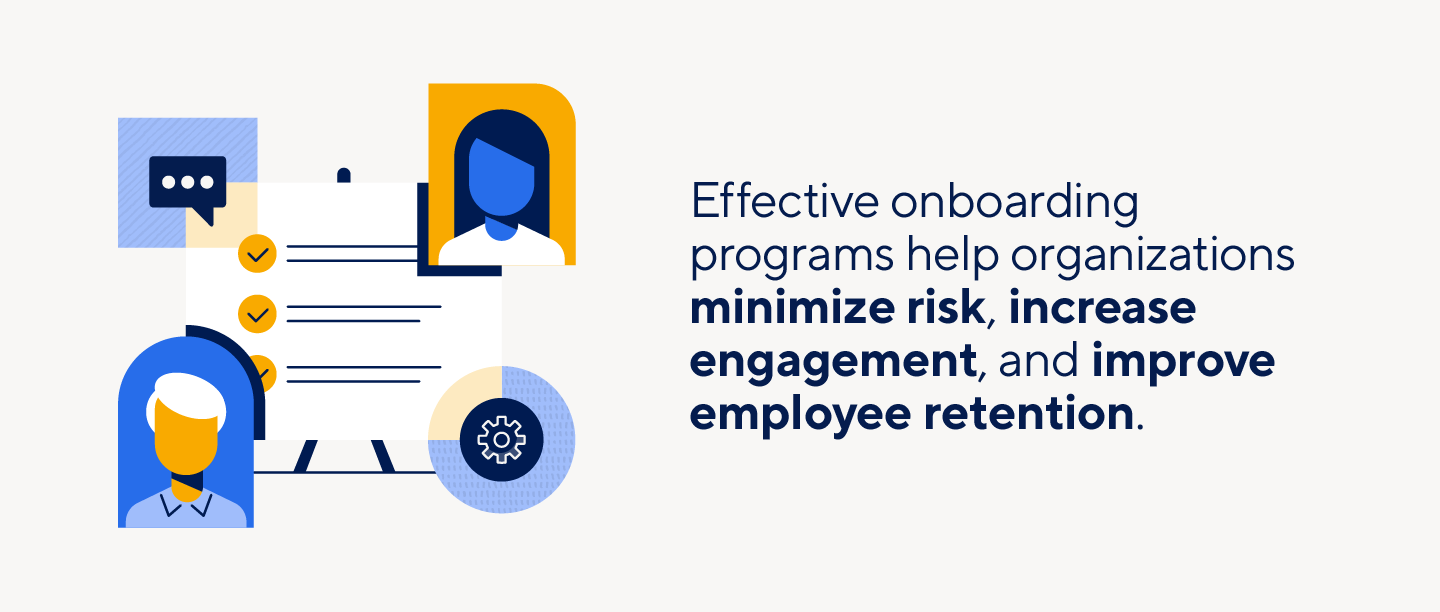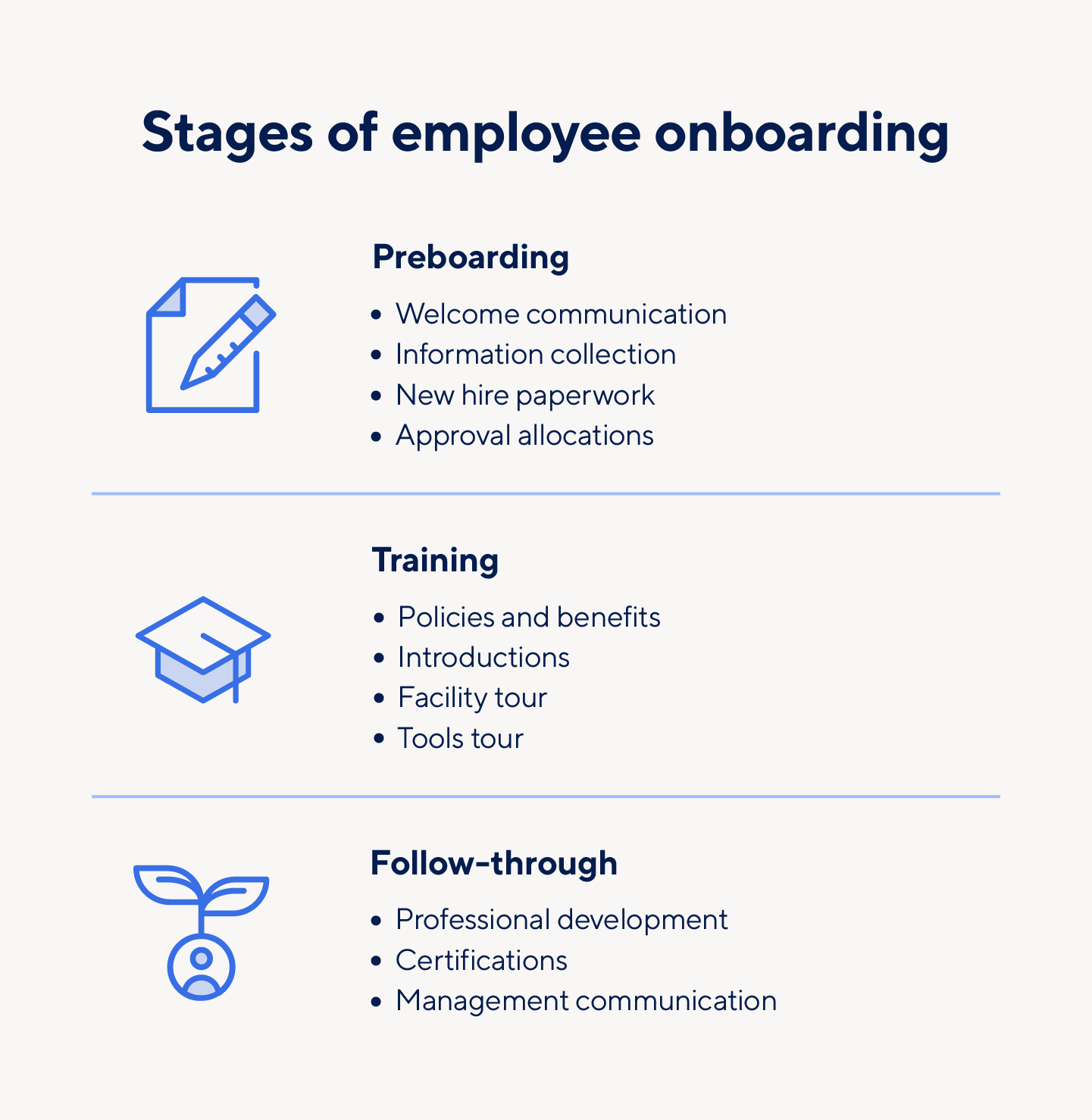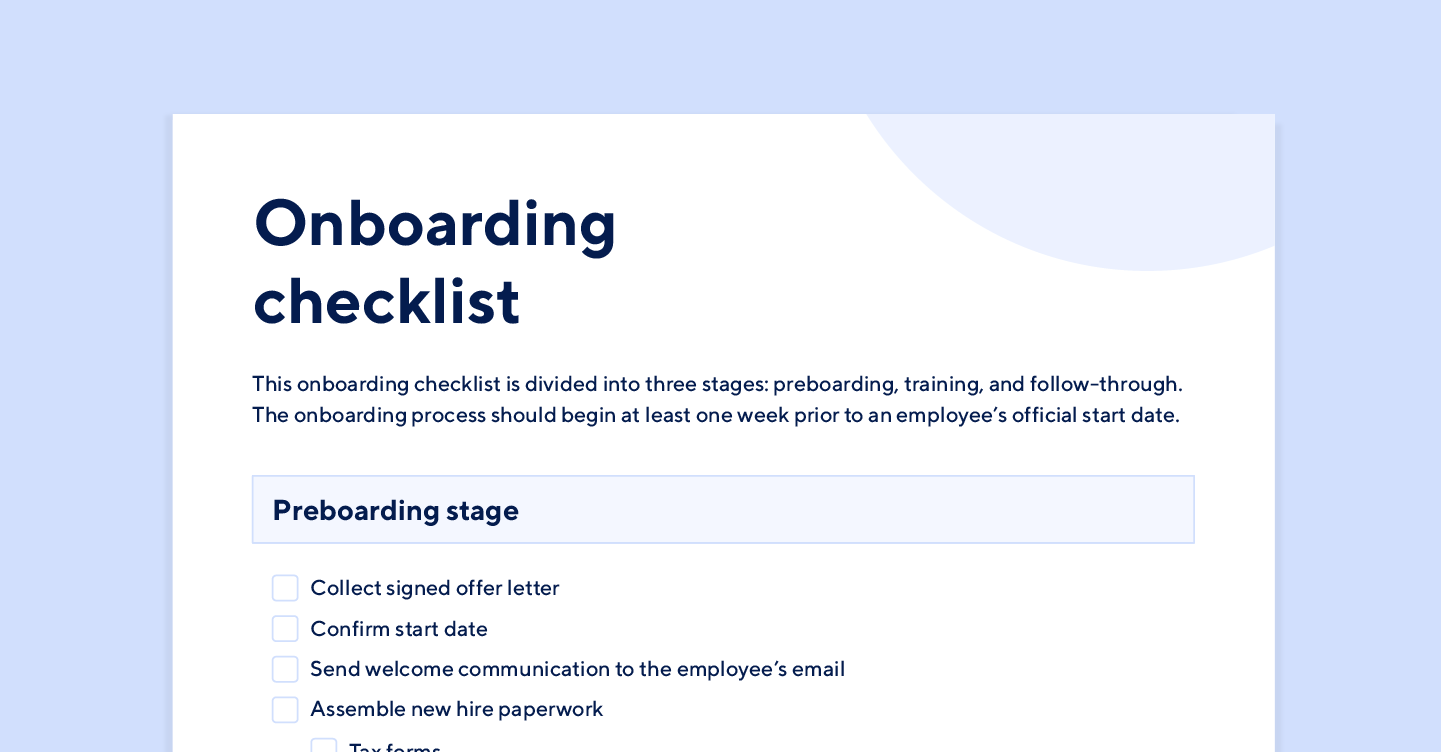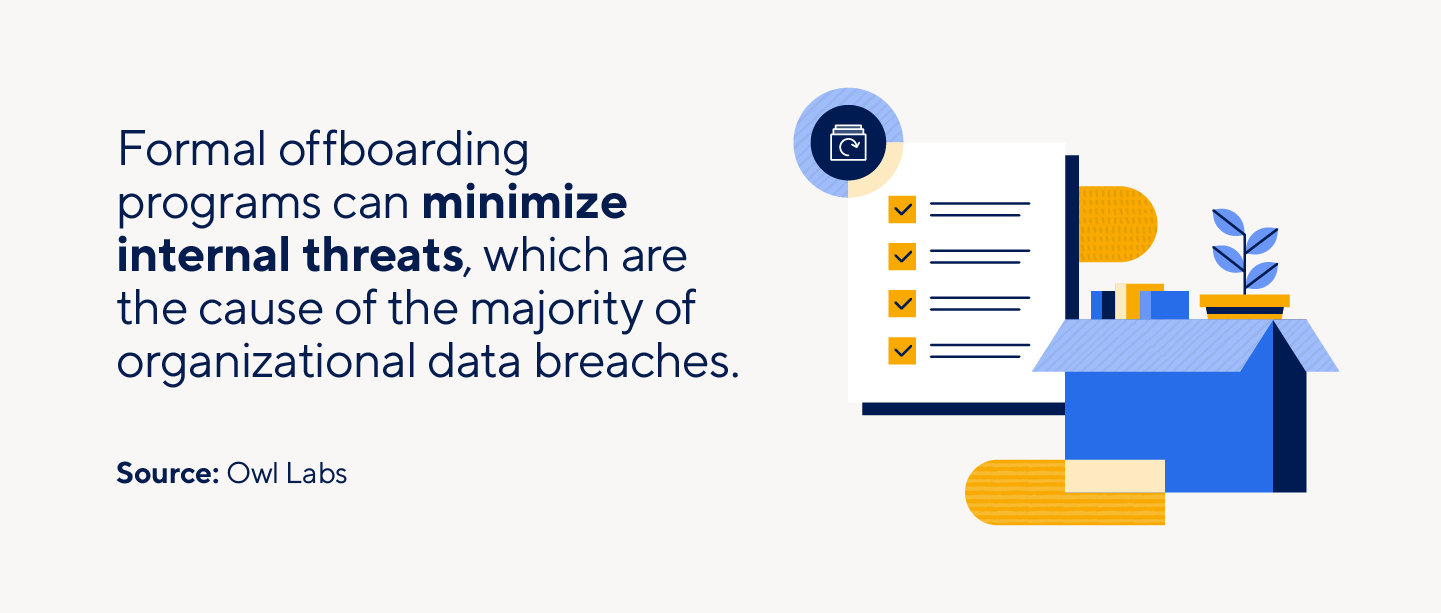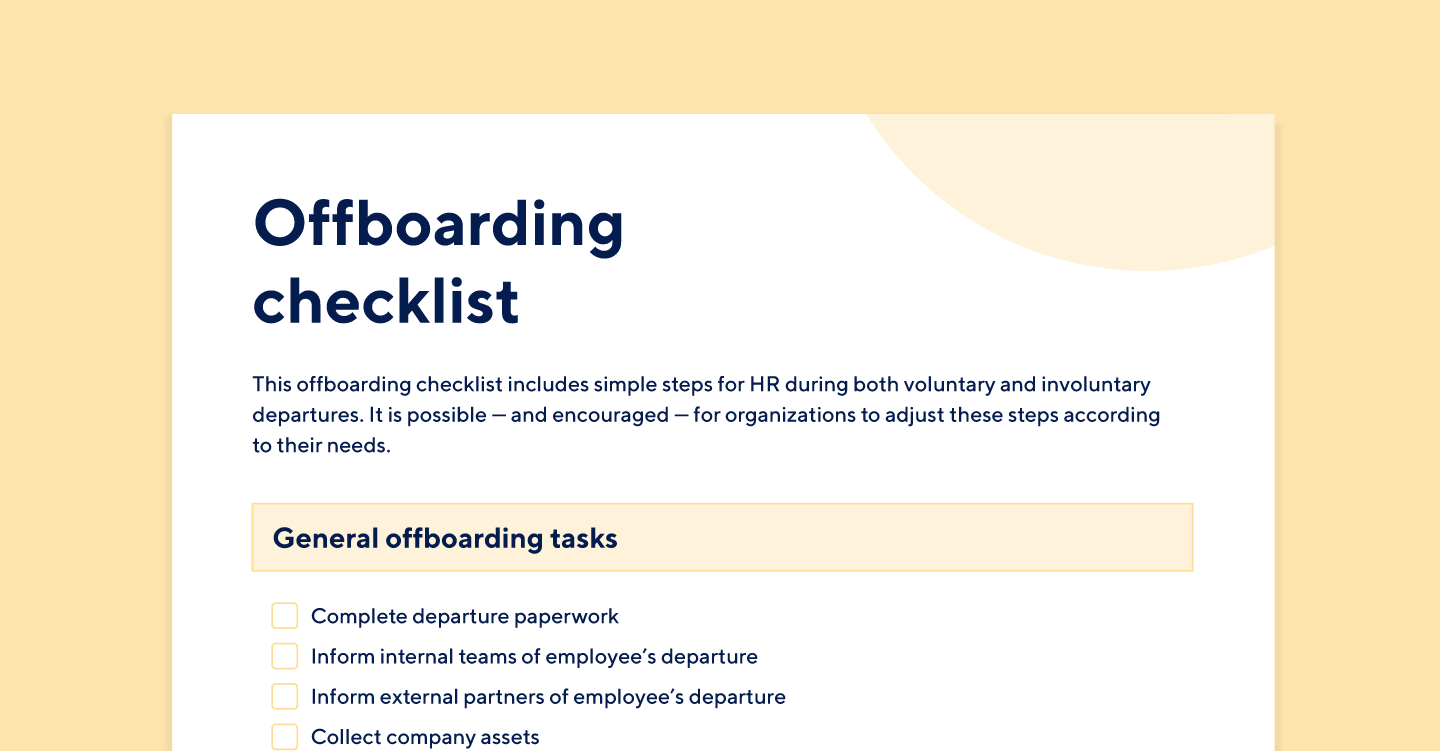What Is Onboarding?
Onboarding is the process of integrating a new employee into the internal organizational system of a company. Onboarding is not a single step, but a series of steps that only ends when an employee begins to consistently perform at a predetermined level.
This series of steps can be referred to as the onboarding process, and it begins when an applicant signs their formal offer letter. Onboarding can last months; the length of the process depends on the skills, abilities, and performance of each new employee, and the internal norms of the organization.
Why Is Onboarding Important?
A strong onboarding process is one of the first impressions a new employee receives of your company. The way an employee is trained can greatly impact the processes of an entire organization. Plus, supportive onboarding programs can quickly highlight both the strengths of new team members and potential areas for growth.
Effective onboarding programs also have various organizational benefits:
- Minimized risk: Employees supported by strong onboarding programs are more likely to be engaged in their work, and to understand the mission and values of their organization, which can help manage risk.
- Retention: Onboarding programs that promise to invest in new employees, while carefully and thoroughly guiding them through expectations and new initiatives, can help increase retention.
- Increased engagement: A majority of employees agree that professional, job-specific training programs help increase their work engagement at the start of their employment.
- Potential ROI: Supported employees are more likely to strive for (and reach) employment goals, achieving higher returns on their personal and professional investments.
- Employee productivity: Elevated onboarding programs help initiate relationships between new employees and other departments. They help an employee get situated with the organization’s learning tools, programs, and software.
- Improved communication: Employees meet and engage with various team members during the onboarding process, which can encourage one-on-one communication within teams and across departments.
- Improved compliance: New employees are immediately introduced to company codes of conduct and software goals, which can help them stay aware of compliance expectations throughout their employment.
How Long Is the Onboarding Process?
Onboarding experts and organizational leaders agree that the onboarding process should take at least three months to be the most effective. However, the length of an onboarding process is unique for every organization — and every employee.
There are a few main factors that can affect the length of the onboarding process, including the following:
- The types of programs and software an organization uses
- The department sizes within an organization
- The seniority and position a new employee is filling
- The role expectations an employee is expected to fulfill
It’s important to ask for feedback from new and current employees about their onboarding experience at your organization. They have the best insights into the program’s process, like how long it should take and what needs to be covered within certain periods of time.
3 Stages of the Employee Onboarding Program
The timeline and procedures within an onboarding process are unique to individual organizations, but most programs still include three general stages that begin after a candidate signs an offer letter: preboarding, training, and follow-through.
1. Preboarding Stage
The preboarding stage of the onboarding process begins a week before an employee is expected to begin working for an organization. This stage includes preparation such as welcome communication, collecting personal information, new hire paperwork, and approval.
Let’s take a look at each of these steps in more detail:
- Welcome communication: Introduce an employee to their training contacts and give a brief overview of the onboarding process.
- Information collection: Collect and verify the employee’s personal information, including their legal name.
- New hire paperwork: Prepare new hire paperwork, including compliance, benefits forms, nondisclosure agreements, and handbook acknowledgment forms.
- Approval allocations: Determine tool access and license approvals an employee will need before beginning training.
The preboarding stage ends once an employee has begun formal on-the-job training.
2. Training Stage
The second stage of onboarding — the training stage — begins on an employee’s start date. It typically lasts about one week and frequently includes common organizational training, such as policy and benefits training, introductions, an office tour, and a tools tour.
Let’s look at these in more detail:
- Policy and benefits training: Employees receive training on the company’s policies, expectations, and employee benefits.
- Introductions: Employees are introduced to managers, team members, other coworkers, and company leadership.
- Facility tour: If working in person, employees receive a tour of the organization, including every department’s facilities.
- Tools tour: At this stage, employees are introduced to the online and physical tools they’ll need to successfully carry out their responsibilities.
Depending on the organization, this stage could last longer than a single week; the organization can decide when this stage ends and the next one begins.
3. Follow-Through Stage
The third stage of the onboarding process is the follow-through stage. This stage is ongoing and typically lasts around six months — or through the end of an employee’s trial period. This stage focuses on the development of the employee as a whole, including the following:
- Professional development: Management should organize regular on-the-job trainings and encourage employees to regularly engage.
- Certifications: Organizations should encourage employees to receive external training for certifications.
- Manager communication: Managers should consistently communicate with employees to discuss problem areas or deliver constructive feedback and praise.
Even after an employee successfully completes the onboarding process and trial period, the organization should encourage professional development and communication with managers.
Onboarding Checklist Template
Download the Onboarding Checklist Template for
Microsoft Word
|
Adobe PDF
| Google Docs
This onboarding checklist guides users through all three stages of the onboarding process — preboarding, training, and follow-through — and helps HR and new employees stay on track.
View our comprehensive roundup for more detailed onboarding checklists to help keep HR, IT, and department teams moving through the process with new employees.
What Is Offboarding?
Offboarding refers to the actions both an employer and employee take after an employee communicates their intention to leave a company. During this time, employees are removed from organizational systems and access to company programs.
Offboarding is an essential part of company security — it allows organizations to ensure their systems are only accessible to authorized parties.
Before and during employee offboarding, organizations should consider the potential challenges of the process, including employee risk level, asset retrieval, and communicating the change.
More detail on each of these below:
- Employee risk level: Organizations should gauge the risk level of every departing employee — both voluntary and involuntary departures. Employers can assess these risk levels through exit interviews.
- Asset retrieval: Companies should carefully retrieve and catalog the organizational tools an employee used or was responsible for during their employment. This can include physical assets (like monitors) or digital assets (like VPNs and software licenses).
- Passwords and downloads: Shared passwords should be changed after an employee’s departure, and their physical equipment should be wiped of any personal or professional downloads.
- Offboarding notifications: Some employee departures should be kept discreet. Only reveal enough information to satisfy a former employee’s team, and make sure they are comfortable — with both what is communicated, and to whom it is communicated.
Why Is Offboarding Important?
No matter who leaves an organization, the offboarding process is essential. This is a time when employees and company leadership can engage in open, authentic communication concerning an employee’s time at an organization.
Offboarding allows organizations and employees to respectfully communicate about the following:
- Insights: Employers and former employees can discuss which processes in the organization worked or didn’t work, and suggest various improvements.
- Frustrations: Departing employees may leave an organization frustrated with a company’s policies, procedures, and processes. During the offboarding process — usually in an exit interview — these employees have the opportunity to express these concerns.
- Role transitions: Offboarding is for more than just former employee-to-leadership communication. It's also when managers are expected to communicate to organizational teams about the potential transitions that could occur after an employee’s departure.
How Long Is the Offboarding Process?
The duration of offboarding, like onboarding, depends on the organization’s specific processes. Even so, the amount of time an organization has to complete its offboarding obligations depends on the circumstances of an employee’s leave.
Additionally, offboarding can be affected by other factors, such as the following:
- The standing of an employee’s relationship with the organization
- The reason for departure, which can be determined by the employee or organization
- The ability of an organization to transition teams or other employees without too much disruption
- The timeline stated by an employee in a letter of resignation
Offboarding can be sudden, due to either voluntary or involuntary departures. This means the parties may have anywhere from a few weeks to a single day to complete the process. The organization needs to evaluate each different scenario to determine the duration of the offboarding process.
Offboarding Process: What to Consider
The offboarding process is a crucial step in the employee lifecycle, but it needs to be facilitated carefully. Before creating an offboarding checklist and determining the essential steps in the process, consider these factors:
- Relationship maintenance: Expressing a commitment to maintain professional relationships with former employees can reiterate that the organization is also committed to its professional relationships with current and future employees.
- Business health: In addition to relationship maintenance, offboarding processes can focus on organizational insights and company expectations. This can help an organization clarify and build on the values it prioritizes.
- Risk management: There are security and legal risks during and after offboarding. Processes designed to minimize these risks help protect the organization’s relationships with past, present, and future employees.
- Exit interviews: Exit interviews — for both voluntary and involuntary departures — can cause tension. However, they can also help organizations understand areas of growth and strength. Carefully consider your discussion questions before conducting an exit interview, and understand the complications that could arise from disgruntled or angry former employees.
Offboarding Checklist Template
Download the Offboarding Checklist Template for
Microsoft Word
|
Adobe PDF
| Google Docs
This offboarding checklist is designed to help HR complete the final step in the employee lifecycle. It includes a list of general offboarding procedures and assets that need to be retrieved during the offboarding process.
Streamline Onboarding and Offboarding With Real-Time Work Management in Smartsheet
Empower your people to go above and beyond with a flexible platform designed to match the needs of your team — and adapt as those needs change.
The Smartsheet platform makes it easy to plan, capture, manage, and report on work from anywhere, helping your team be more effective and get more done. Report on key metrics and get real-time visibility into work as it happens with roll-up reports, dashboards, and automated workflows built to keep your team connected and informed.
When teams have clarity into the work getting done, there’s no telling how much more they can accomplish in the same amount of time. Try Smartsheet for free, today.
